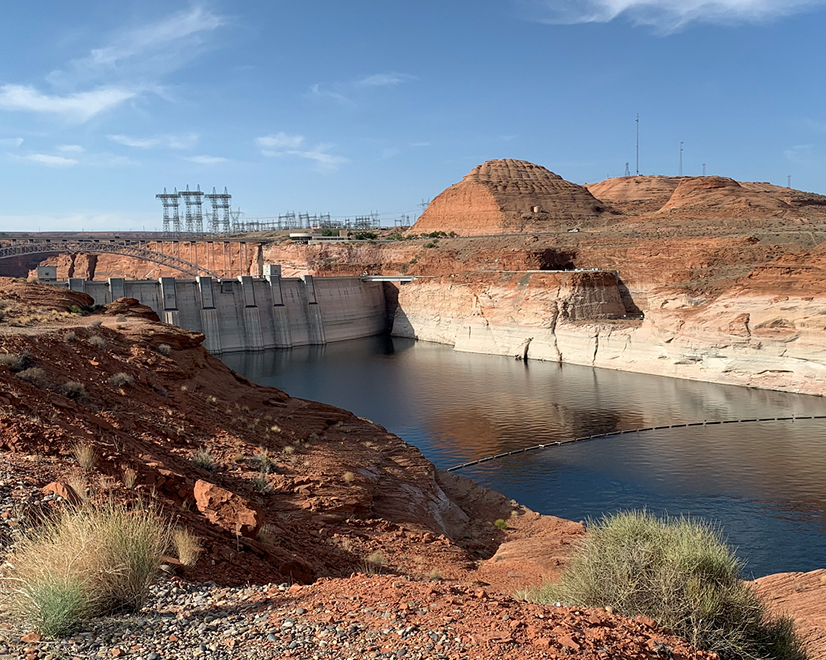
The U.S. Bureau of Reclamation has for the first time declared a water shortage for Lake Mead in response to a historic drought impacting the entire Colorado River Basin.
The agency’s latest 24-month study for the Colorado River Basin, released Monday, projects that Lake Mead’s water level will dip to 1,065.85 feet as of Jan. 1, 2022, about 9 feet below the 1,075-foot level needed to trigger a shortage determination.
Lake Mead is a reservoir formed by the Hoover Dam on the Nevada-Arizona border. Under the Level 1 shortage declared for the lake, water supply to Arizona will be reduced by 512,000 acre-feet, or about 18% of the state’s annual allotment.
Nevada will see a reduction of 21,000 acre-feet, or about 7% of the state’s yearly apportionment, while Mexico’s water reduction will be 80,000 acre-feet, about 5% of the country’s annual allotment. The reductions are determined through a set of water agreements.
“Like much of the West, and across our connected basins, the Colorado River is facing unprecedented and accelerating challenges,” Tanya Trujillo, assistant secretary for water and science, said Monday in a news release.
The water-shortage declaration will impact operations during water year 2022, which runs from Oct. 1, 2021, through Sept. 30, 2022.
Flows from Lake Powell, a reservoir at the Utah-Arizona border, will also be reduced during water year 2022, the bureau said.
The bureau’s new 24-month study projects Lake Powell’s elevation to be 3,535.40 feet on Jan. 1, 2022, about 165 feet below full and about 45 feet above minimum power pool. Based on this projection, Lake Powell will operate in the mid-elevation release tier in water year 2022.
Historic Drought Conditions
The Upper Basin of the Colorado River, which lies in the Rocky Mountains and provides most of the river’s flow, experienced an exceptionally dry spring this year, the bureau said. Runoff into Lake Powell from April to July was just 26% of average.
The Colorado River system’s total storage is at 40% of capacity, down from 49% at this time last year.
The drought is affecting much of the Western U.S. Earlier this month, the California Department of Water Resources announced it was shutting down the Hyatt Power Plant at Lake Oroville for the first time due to falling lake levels.
“California and much of the western part of the United States are experiencing the impacts of accelerated climate change, including record-low reservoir levels due to dramatically reduced runoff this spring,” DWR Director Karla Nemeth said in a statement.
Arizona Impacts
Water reductions from Lake Mead to Arizona will be borne mainly by users of the Central Arizona Project (CAP), a 336-mile-long system that delivers Colorado River water to Maricopa, Pinal and Pima counties, where more than 80% of the state’s population lives.
For now, the Lake Mead reductions mean less water for central Arizona agriculture operations, CAP said.
But if the water shortage reaches levels 2 or 3, reductions would impact CAP water supply to some central Arizona cities and tribes, CAP said in a fact sheet.
“Given the recent intensification of the drought, it is likely there will be deeper levels of shortage in the next few years,” CAP said.
For the current water year, the Colorado River is operating at “tier zero,” which has required Arizona to contribute 192,000 acre-feet of the state’s annual 2.8-million-acre-foot allotment to Lake Mead. The contribution is coming entirely from CAP, according to a joint statement from CAP and the Arizona Department of Water Resources (ADWR).
The statement, issued in April, anticipated the Bureau of Reclamation would issue a tier-one shortage declaration for water year 2022.
The state has been managing the water cutbacks through a drought contingency implementation plan.
“In the plan, some [users] are committing to leaving extra water in Lake Mead to reduce future risks, while others are sharing water with the most severely impacted of the state’s water users, central Arizona agriculture,” the statement said.
“The result is the Arizona water community is prepared, even in the midst of a decades-long drought,” CAP and ADWR said.